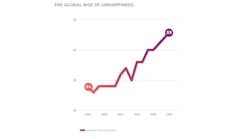The ASID 2023 Trends Outlook is here. Every year this highly anticipated report identifies and explores trends specific to each market sector as part one of the organization’s three-part Outlook Report series. It will be followed by the Economic Outlook and State of Interior Design reports later this spring.
At no other time in history have we felt with such magnitude the impact of design on our lives—especially when it comes to healthcare. The trends outlook states that as Americans settle into a new normal, the global mental health crisis is top of mind for all. The landscapes of cities and workplaces are changing, and workers are experiencing stress at peak levels, especially those in the U.S. and Canada, even more so than in 2020 according to its findings. To address this, interior designers are, of course, shifting attention to wellness and holistic healthy living, with choices in colors and lighting that address both the mind and body. Maximized use of daylight, plants and natural materials, spa-like bathrooms and retreat spaces for exercise and meditation are all vital in supporting employee wellbeing in the workplace.
The Trends Outlook Report also shows that sustainability has become a must for consumers who are now favoring companies they find to be making a positive impact on the environment, going as far as to pay a premium for some purchases if they are more sustainable. The report also predicts that design will see a new wave of technology ushered in with the use of Artificial Intelligence (AI) and designing for the metaverse. AI is extending into all areas of design practice, with advancements aiding design teams by reducing overall lead times on projects and expanding creative discovery by memorizing insights from thousands, if not millions, of previous project data using specified computer vision.
Here are a few other occupant-centered insights from this year’s report that show how the residential and commercial realms can affect one another, helping practitioners support each other across the country.
Mental Health as a Major Public Health Concern
This is a challenge to families, workplaces and communities. Unhappiness around the world is at a record high, with people experiencing increased feelings of anger, sadness, pain, worry and stress. Designers, with their ability to creatively design and modify interior environments, can play a key role in supporting mental health and wellbeing (see above for ideas on how).
New Home Buyers Equal New Expectations
The make-up of recent home buyers has changed due to rising costs and demographic shifts. Soaring home prices, increases in mortgage loan rates and competition have pushed many first-time home buyers out of the market. New homebuyers and apartment dwellers alike have expressed design preferences for multi-functional spaces that prioritize health and wellness—similar to their needs in the workplace. Residential spaces need to be oases for relaxation, offering respite from external stressors, and materials used must demonstrate a commitment to sustainability by both the builder and the end user.
Universal Design Abounds
Designers of senior living communities should be aware of the rise of multigenerational homes and the desire to age in place. This is prompting designers and builders to meet a growing demand for accessible homes that are inclusive to users of all age groups, abilities and demographics.
The Office Return
As the job market gradually cools, employers are offering fewer remote-work positions and requiring more current remote workers to return to the workplace. Job seekers want remote work options, but on-site only job posts are becoming more common.
The Workplace Becomes More Accessible
ASID’s 2023 Trends report found that older Americans are opting for “rewirement,” rather than retirement. The return of retirees to the active workplace has forced work environments to adapt to accommodate aging employees. Traditional office environments of the past—noisy, crowded and brightly lit—could also overwhelm the neurodivergent population. Acknowledging neurodiversity ultimately means providing flexible and adaptable workspaces, where all members of the neurodivergent community feel comfortable and included. Today’s workplaces need to support hybrid work arrangements, inclusion and accessibility for neurodivergent employees, as well as the use of more smart technologies for multi-modal use.
Interior designers are uniquely poised to address these, our world’s most pressing challenges in 2023, and at ASID, we are excited to watch our membership lead us into the year ahead. Designers have been called upon to better our world in unprecedented ways, and the impact of good design has become immeasurable.
The 2023 Trends Report is now available for download at asid.org.
